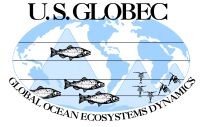
Participants
__________
GLOBEC
International
__________
| GLOBEC Northeast Pacific Program Mapping of Physical and Biological Fields in the Northern California Current July 31 - August 19, 2002 |
 |
August 7, 2002 Mesoscale survey complete. SeaSOAR investigates the eddy at 42 40'N, 125 35'W. 8:00 a.m.: The Revelle has finished the entire mesoscale survey and during the night has followed a path back to the center of line 9. This morning the SeaSOAR and HTI will be in the water trying to locate the center of the chlorophyll-rich eddy that was detected a few days ago. Once the center is located, the ship will stop and the CTD will be lowered to collect water samples. 9:00 a.m.: The SeaSOAR and HTI were recovered and preparations are underway to lower the rosette and profiler to collect water samples and measurements of the eddy. 11:00 a.m.: The first cast was made with the rosette. The rosette was lowered to 1,000 meters. Using a computer in the lab, the bottles were triggered to open at different depths to collect samples from the eddy. After it was retrieved, Amanda Ashe and Mauricio Andrades collect the water samples for analysis in the main lab. 12:00 p.m.: With the rosette out of the way it is now time to launch the bio-optics profiler. The profiler frame, which holds many different instruments for measuring the optical characteristics of the chlorophyll in the water, is lowered to a depth of 200 meters by the winch operator. Data from the instruments comes back up the fiber optics line inside the cable to the main lab where it is recorded on a computer. After a final check by Chris Wingard and Ricardo Letelier, the profiler is deployed by Cidney Howard and Chris. 2:00 p.m.: The Revelle has moved on to a different location over the eddy and performed another rosette cast. A total of five locations will be sampled with the rosette which will last through the night. After the sampling is complete, the Revelle will be traveling north again to the Newport area. Here Chris Wingard and Mauricio Andrades recover the rosette under the direction of Revelle resident technician Tami Baiz. 3:00 p.m.: The Revelle has a unique engine system that makes it ideal for oceanography work. For some experiments, such as a rosette deployment, the ship is required to stay in one position . This is accomplished by using the two propellers aft and two thrusters on the bow. The propellers and the thrusters are both operated by electric motors. The electricity for those motors comes from 3 diesel engine powered electric generators. Additional diesel engine generators are used to supply the ship lights and instruments with electricity. Waste heat from the engines is used to operate an evaporation system that produces fresh water from sea water. Electrician for the Revelle, John Taylor, shows the Z-drive system that allows the propellers for the Revelle to move through 360 degrees of motion, electric control panels, evaporative fresh water system, and the diesel moters. Specifications on the R/V Roger Revelle can be found here. 7:30 p.m.: At eddy station three, a drifter was deployed that will measure optical characteristics of sea water. Data from this drifter will be transmitted to the Argos satellite and relayed to the scientists back at OSU. Shown below are John Hercher and Ricardo Letelier deploying the drifter assisted by Tami Baiz. The Revelle will be stopping at two more stations in the eddy tonight to collect samples with the rosette. After they are complete we will travel north to begin more station work on Thursday.
|
This page was last updated on August 08, 2002 10:36 AM
.jpg)
.jpg)
.jpg)
.jpg)
.jpg)
.jpg)
.jpg)
.jpg)
.jpg)
.jpg)
.jpg)
.jpg)
.jpg)
.jpg)
.jpg)
.jpg)
.jpg)
.jpg)
.jpg)
.jpg)
.jpg)
.jpg)
.jpg)
.jpg)
.jpg)
.jpg)
.jpg)
.jpg)
.jpg)
.jpg)
.jpg)
.jpg)
.jpg)
.jpg)


